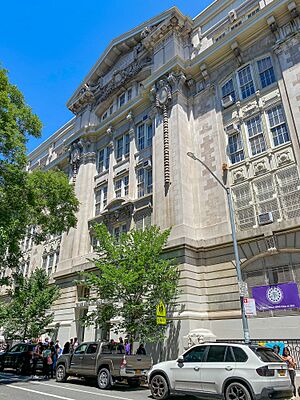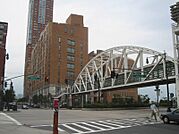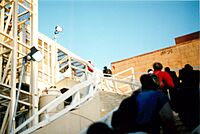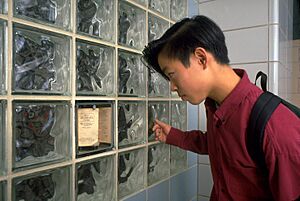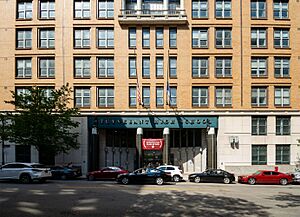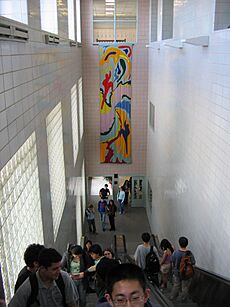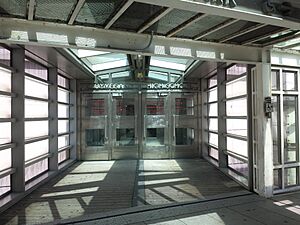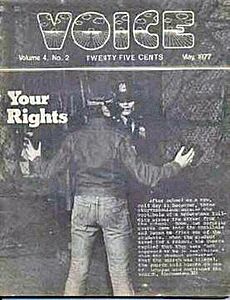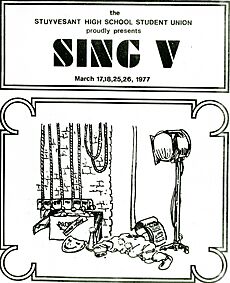Stuyvesant High School facts for kids
Quick facts for kids Stuyvesant High School |
|
|---|---|
 |
|
| Address | |
|
345 Chambers Street
, 10282
United States
|
|
| Coordinates | 40°43′04″N 74°00′50″W / 40.7179°N 74.0138°W |
| Information | |
| School type | Selective public high school |
| Motto | Latin: Pro Scientia Atque Sapientia (For knowledge and wisdom) |
| Established | 1904 |
| School district | New York City Department of Education |
| School number | M475 |
| CEEB code | 334070 |
| NCES School ID | 360007702877 |
| Principal | Seung Yu |
| Faculty | 162.92 (on FTE basis) |
| Enrollment | 3,334 (2022-23) |
| Student to teacher ratio | 20.46 |
| Athletics conference | PSAL |
| Mascot | Pegleg Pete |
| Nickname | Stuy |
| Team name | Peglegs |
| USNWR ranking | 26 |
| Newspaper | The Spectator |
| Yearbook | The Indicator |
| Nobel laureates | 4 |
Stuyvesant High School (often called Stuy by students) is a special public high school in New York City. It helps students get ready for college. The school is run by the New York City Department of Education. It offers advanced classes for free to students who live in the city.
Stuyvesant first opened in 1904 as a school for boys. It was located in the East Village. In 1934, students had to pass an entrance test to get in. Girls were first allowed to attend in 1969. The school moved to its current, larger building in Battery Park City in 1992. This was because the old building was too small for all the students.
To get into Stuyvesant, students must pass the Specialized High Schools Admissions Test. Each March, about 800 to 850 students with the highest scores are accepted. Around 30,000 students take the test each year. Stuyvesant also has many fun clubs and activities. These include a theater show called SING! and student newspapers.
Many famous people have gone to Stuyvesant. These include former U.S. Attorney General Eric Holder and actor James Cagney. Stuyvesant is one of only six high schools in the world with four or more Nobel laureates as alumni.
Contents
- Discovering Stuyvesant High School's Past
- Exploring Stuyvesant High School's Buildings
- Getting to Stuyvesant High School
- Student Life and Admissions at Stuyvesant High School
- Academics at Stuyvesant High School
- Extracurricular Activities at Stuyvesant High School
- Stuyvesant High School's Reputation
- Notable People from Stuyvesant High School
- Stuyvesant High School in Movies
- See also
Discovering Stuyvesant High School's Past
How Stuyvesant High School Began
In 1887, William Henry Maxwell, New York City's Superintendent of Schools, first wrote about needing trade schools. These schools would teach practical skills. The first trade school in the city opened in Brooklyn in 1893. By 1899, Maxwell wanted a similar school in Manhattan.
In 1903, Maxwell and C. B. J. Snyder suggested creating a trade school in Manhattan. The Board of Education agreed in April 1904. They planned for the school to be on East 15th Street. However, that building was not ready. So, the new school first opened in an old building on East 23rd Street. The Board of Education named it Stuyvesant High School. This name was chosen because it reminded people of the local area. The area was named after Peter Stuyvesant, an old Dutch governor.
Early Days as a Boys' School
Stuyvesant High School opened in September 1904. It was Manhattan's first trade school for boys. When it first opened, it had 155 students and 12 teachers.
At first, the school taught subjects like English, math, and science. It also had classes in woodworking and metalworking. In 1908, the trade classes became separate. Stuyvesant then became known for its strong focus on math and science. By 1909, most of its graduates went to college. This was a much higher number than other schools.
By 1919, Stuyvesant started to limit who could get in. They based admission on how well students did in school. The school also used a "double session" plan. Some students went in the morning, others in the afternoon. This helped fit more students. In 1934, the school started using entrance exams. This exam system was also used for the new Bronx High School of Science in 1938.
In 1956, a group of six students built a cyclotron. This is a machine that speeds up tiny particles. Six years later, a small test of the machine worked. But a full-power test caused a power outage for the school and nearby buildings!
Becoming a School for Both Boys and Girls
In 1967, a girl named Alice de Rivera sued the Board of Education. She said she was not allowed to take Stuyvesant's entrance exam because she was a girl. She won the lawsuit. Stuyvesant then had to accept female students. The first girls joined in September 1969. There were 12 of them. The next year, 223 girls were accepted. By 2015, girls made up 43% of all students.
In 1972, a law was passed that named Stuyvesant and a few other schools as "specialized high schools." This law said there would be one test for admission to these schools. This test is called the Specialized High Schools Admissions Test (SHSAT). It checks students' math and reading skills.
Stuyvesant High School and 9/11
The current school building is about half a mile from the World Trade Center. This area was attacked on September 11, 2001. The school was evacuated during the attack. The building was covered by smoke, but it was not damaged. No one at the school was physically hurt.
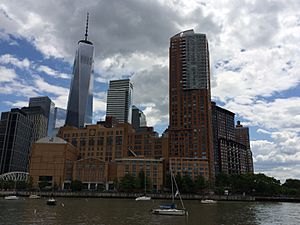
When classes started again on September 21, 2001, students went to Brooklyn Technical High School. The Stuyvesant building was used by rescue workers. This made Brooklyn Tech very crowded. Stuyvesant students had to go to school in the evening. Normal classes at Stuyvesant started again on October 9.
Because Stuyvesant was so close to the World Trade Center site, there were worries about dust. The U.S. EPA said the school was safe. They cleaned the building thoroughly. However, some people, like former teachers and students, reported health problems later. A group of Stuyvesant alumni has been working to get health benefits for those affected.
Nine former students died in the World Trade Center attack. The school newspaper, The Spectator, made a special issue about 9/11. Students wrote stories and shared photos. An English teacher, Annie Thoms, helped students turn their experiences into a book called With Their Eyes.
Recent History of Stuyvesant High School
From 2003 to 2004, Stuyvesant celebrated its 100th birthday. They had many events, including a parade and a big reunion. Famous alumni also visited and gave speeches.
Many important people have given graduation speeches at Stuyvesant. These include former U.S. Attorney General Eric Holder and former President Bill Clinton. Others include United Nations Secretary General Kofi Annan and astrophysicist Neil deGrasse Tyson.
Exploring Stuyvesant High School's Buildings
The Original 15th Street Building
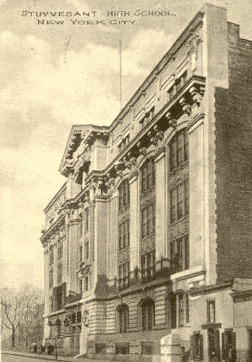
In August 1904, the Board of Education asked Snyder to design a new building for Stuyvesant. The new school was shaped like the letter "H". This shape allowed more natural light into the building. Construction began in September 1905. It cost about $1.5 million to build. In 1907, Stuyvesant moved to this new building on 15th Street.
The new building could hold 2,600 students. This was more than double the old building's capacity. It had many classrooms for trade skills, plus regular classrooms and a large auditorium.
In the 1950s, the building was updated. It got new classrooms, shops, and cafeterias. This cost $2 million.
By the 1970s and 1980s, the building was getting old and worn out. It was used too much and not maintained enough. The building was too small for thousands of students. So, the New York City Board of Education decided to move the school. The old 15th Street building is still used today. It now houses three other schools.
The Current Stuyvesant High School Building
In 1987, New York City Mayor Ed Koch and New York State Governor Mario Cuomo announced a new Stuyvesant building. It would be in Battery Park City. The land for the new school was donated. The building was designed by Gruzen Samton Steinglass and Cooper, Robertson & Partners.
The principal at the time, Abraham Baumel, visited many labs for ideas. The new 10-story building has 12 laboratory rooms. It also has escalators, glass-walled studios, a swimming pool, and five gyms. Construction started in 1989. When it opened in 1992, it was the first new high school in New York City in ten years. The new Stuyvesant Campus cost $150 million. This made it the most expensive high school building in the city at that time. The library can hold 40,000 books.
Soon after the building was finished, the $10-million Tribeca Bridge was built. This bridge lets students enter the school without crossing a busy street. The building is also designed to be accessible for people with disabilities.
In 1997, a part of the math floor was named after Richard Rothenberg. He was the math department chairman who had passed away. A special art piece called "Celebration" was made in his honor. It has 50 wooden boxes with math ideas and thoughts about him.
In 2006, Robert Ira Lewy gave $1 million to create the Dr. Robert Ira Lewy M.D. Multimedia Center. In 2010, the school library joined the New York Public Library system. This allowed students to check out books from any public library.
An escalator accident happened at Stuyvesant High School in 2018. Ten people, including eight students, were hurt. Because of this, some escalators were closed for a few years.
Mnemonics Art Installation
During the building's construction, an art project called Mnemonics was created. Artists Kristin Jones and Andrew Ginzel made it. They placed 400 hollow glass blocks throughout the building. These blocks are in the hallway walls from the basement to the tenth floor.
Each block holds small items that show parts of history, nature, and culture. These items come from ancient times to today. For example, there are pieces of the Great Wall of China and Mayan pyramids. There are also leaves from the sacred Bo tree and water from the Nile River. Some blocks even contain pieces of the old 15th Street Stuyvesant building. There is also a report card from a student who studied there. Empty blocks were also put in. These will be filled by future graduating classes until the year 2080. This art project won an award for excellent design.
Getting to Stuyvesant High School
Students can get to Stuyvesant using the New York City Subway. The Chambers Street station and the Chambers Street–World Trade Center station are nearby. Several New York City Bus routes also stop close to the school. Students who live far from the school get special MetroCards. These cards help them pay for public transportation.
Student Life and Admissions at Stuyvesant High School
| Race and ethnicity | Total | |
|---|---|---|
| Asian | 71.7% |
|
| White | 18.3% |
|
| Hispanic | 3.8% |
|
| Two or more Races | 3.5% |
|
| Black | 1.4% |
|
| American Indian/Alaska Native | 0.7% |
|
| Native Hawaiian/Pacific Islander | 0.6% |
|
| Sex | Total | |
| Male | 58% |
|
| Female | 42% |
|
| Income | Total | |
| Economically disadvantaged | 48% |
|
How to Get Admitted to Stuyvesant High School
Stuyvesant has over 3,000 students. It is open to New York City residents entering ninth or tenth grade. To get in, students must take the three-hour Specialized High Schools Admissions Test. About 28,000 students took this test in 2017.
The score needed to get into Stuyvesant is always higher than for other specialized schools. Admission depends on a student's test score. It also depends on how they rank Stuyvesant among other specialized schools. The test covers math and reading skills. Some people have said the test might not be fair to all students.
Academics at Stuyvesant High School
Stuyvesant offers a college-prep curriculum. This means it helps students get ready for college. Students take four years of English, history, and science classes. Science classes include biology, chemistry, and physics. Students also take four years of math.
They also take three years of one foreign language. There are also classes in art, music, health, and computer science. Stuyvesant offers many elective courses. Some interesting ones include astronomy, New York City history, and computer graphics design. Most students finish their main courses by junior year. They often take calculus in their senior year. More advanced students can take even higher-level math.
Stuyvesant offers many Advanced Placement (AP) courses. These courses are like college classes. They cover subjects like math, science, history, English, and foreign languages. Taking AP courses can help students earn college credit. For example, after AP computer science, students can take classes in computer graphics and software development. There's also a class where students can earn a Cisco Certified Network Associate (CCNA) certification.
Stuyvesant teaches many foreign languages. These include Mandarin Chinese, French, German, Japanese, Latin, and Spanish. In 2005, Arabic was also added. The science departments offer many advanced classes. These include molecular biology, human physiology, organic chemistry, and astronomy.
Even though Stuyvesant is known for math and science, it also has strong humanities programs. The English Department offers classes in British literature, Shakespeare, and creative writing. Social Studies classes include global history, American history, economics, and government. Other electives include American foreign policy and civil law.
In 2004, Stuyvesant partnered with City College of New York. This allows students to take advanced after-school courses for college credit. These courses are taught by Stuyvesant teachers.
Stuyvesant students do very well on college entrance exams. In 2010, the average SAT score was 2087 out of 2400. In 2023, the average SAT score was 1510 out of 1600. Stuyvesant also has more students taking and passing AP exams than almost any other high school. In 2018, 31 AP classes were offered. About 98% of students passed their AP tests.
Extracurricular Activities at Stuyvesant High School
Sports Teams and Activities
Stuyvesant has 32 different sports teams. These include swimming, golf, bowling, volleyball, soccer, basketball, and baseball. They also have track, cricket, football, and lacrosse teams. Stuyvesant even has ultimate frisbee teams.
In 2007, the Stuyvesant football team got a home field at Pier 40. This pier is north of the school. The baseball team also uses the pier. Stuyvesant has its own swimming pool. Unlike many high schools, most Stuyvesant sports teams have unique names. Only a few teams use the traditional "Pegleg" nickname.
Student Government and Leadership
The Stuyvesant Student Union represents the students. It is a student government group. Students are elected each year for each grade. They work to improve student life. They manage clubs and publications. They also organize activities like city trips and fundraisers. The Student Union also speaks for the students when discussing school rules with the administration.
Clubs and Publications at Stuyvesant High School
Stuyvesant allows students to join many clubs, publications, and teams. This system is similar to many colleges. As of 2015, the school had 150 student clubs.
The Spectator Newspaper
The Spectator is Stuyvesant's official school newspaper. It is published every two weeks and is independent from the school. Over 250 students help to publish it. Students can join at any time.
The Spectator was founded in 1915. It is one of Stuyvesant's oldest publications. It has won awards from the Columbia University Graduate School of Journalism's Columbia Scholastic Press Association.
The Voice Magazine
The Voice started in 1973. It was an independent magazine. It became very popular. However, it caused some arguments and a lawsuit. After that, the school made it an off-campus publication.
SING! Theater Competition
The annual theater competition is called SING!. In this event, seniors, juniors, and "soph-frosh" (freshmen and sophomores together) compete. They try to put on the best performance. SING! started in 1947 at another high school. It has grown to many New York City high schools.
SING! at Stuyvesant began as a small event in 1973. Now, it is a huge school-wide event. In 2005, almost 1,000 students took part. Students write, direct, produce, and fund the entire show. They can be actors, singers, or part of the costume and tech crews. They can also join dance groups like Step, Hip-Hop, or Latin dance. SING! performances happen in March or April. The winner is chosen based on scores from each night's show. In 2023, the soph-frosh team won SING! for the first time in 51 years.
Stuyvesant High School's Reputation
Stuyvesant has educated many famous people. These include four Nobel Prize winners. In 2017, U.S. News & World Report ranked Stuyvesant 71st nationally. It was 21st among STEM high schools.
In 2002, Worth magazine reported that 3.67% of Stuyvesant students went to Harvard, Yale, and Princeton. This made it the 9th top public high school in the U.S. In 2007, The Wall Street Journal found that Stuyvesant sent 67 students to eight top colleges. This was 9.9% of its senior class.
Stuyvesant is often left off Newsweek's list of Top 100 Public High Schools. This is because so many of its students score very high on the SAT and ACT. However, U.S. News & World Report included Stuyvesant on its "Best High Schools" list in 2009. It ranked 31st. In 2010, the New York City Department of Education gave it an "A" grade.
Stuyvesant has helped educate several Nobel laureates. It also has many winners of the Fields Medal. It often has the second-highest number of National Merit Scholarship semi-finalists. From 2002 to 2010, Stuyvesant had 103 semi-finalists in the Intel Science Talent Search. This was the second most of any high school. In 2014, it had the most semifinalists in the U.S. with 11.
In the 2010s, some studies looked at how well exam schools like Stuyvesant work. One study compared students who just barely got into Stuyvesant with those who just missed the score. The study found no big difference in how well these two groups did on state exams later.
A Stuyvesant gym T-shirt became famous in the 1980s. This was because Beastie Boys rapper Ad-Rock (Adam Horowitz) wore one in a music video. The band's first drummer, Kate Schellenbach, went to Stuyvesant.
Notable People from Stuyvesant High School
Many famous scientists went to Stuyvesant. These include mathematicians Bertram Kostant and Paul Cohen. Also, physicists Brian Greene and Lisa Randall, and genome researcher Eric Lander. Other well-known alumni include civil rights leader Bob Moses.
Entertainers like songwriter Walter Becker of Steely Dan, musician Thelonious Monk, and actors Lucy Liu, Tim Robbins, and James Cagney also attended. Comedian Paul Reiser and sports anchor Mike Greenberg are also alumni.
In government and business, former United States Attorney General Eric Holder went to Stuyvesant. So did David Axelrod, an advisor to President Obama.
Pulitzer Prize-winning author Frank McCourt taught English at Stuyvesant. His book Teacher Man talks about his time there. Former New York City Council member Eva Moskowitz also graduated from Stuyvesant. So did Bram Cohen, who created BitTorrent. Olympic fencer Albert Axelrod is another notable alumnus. Economist Thomas Sowell also attended Stuyvesant but left early. Russian journalist Vladimir Pozner Jr. was also a student.
Four Nobel Prize winners are Stuyvesant alumni:
- Joshua Lederberg (1941) – Nobel Prize in Physiology or Medicine, 1958
- Robert Fogel (1944) – Nobel Memorial Prize in Economic Sciences, 1993
- Roald Hoffmann (1954) – Nobel Prize in Chemistry, 1981
- Richard Axel (1963) – Nobel Prize in Physiology or Medicine, 2004
Stuyvesant High School in Movies
In the film The Glass Wall, a character named Freddie Zakoyla attended "Peter Stuyvesant High School."
See also
- Education in New York City
- Health effects arising from the September 11 attacks
- List of New York City Designated Landmarks in Manhattan from 14th to 59th Streets


